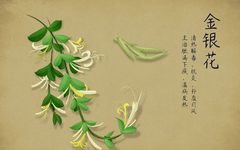People love Honeysuckle (Jin Yin Hua), not only because of its pleasant name, beautiful flowers, and fragrant aroma, but more importantly, it has medicinal value with the ability to clear heat and detoxify, as well as disperse wind-heat.
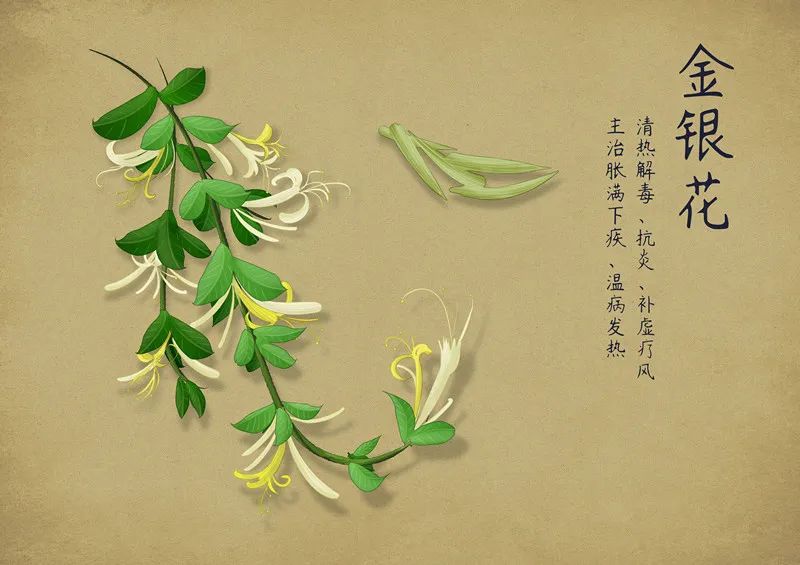
Origin of the Name
Honeysuckle (Jin Yin Hua) is known as the “first flower of summer” and is also called Rén Dōng Huā (忍冬花) in the Newly Revised Materia Medica, Yín Huā (银花) in Wen Bing Tiao Bian, Lù É Huā (鹭鸶花) in Plant Names and Facts, and Shuāng Huā (双花). It blooms in March and is harvested in May, with a faint fragrance and red-tipped flowers. Initially white, the flowers turn yellow after a few days, creating a beautiful contrast of old and new, hence the name Honeysuckle. The flowers grow in pairs, resembling a couple dancing, which is why it is also called Shuāng Huā (双花) or Yuān Yāng Téng (鸳鸯藤). Additionally, it retains its leaves through winter, hence the name Rén Dōng (忍冬).
Botanical Source
Honeysuckle is the dried flower buds or newly opened flowers of the plant Rén Dōng (忍冬), belonging to the Caprifoliaceae family. It is primarily produced in Henan and Shandong.Harvesting occurs in early summer before blooming, and the flowers are dried. They can be used fresh, stir-fried, or made into a decoction.
According to Ming Dynasty’s Chen Jiā Mó in Ben Cao Meng Quan:
Roots and shoots of plants should be harvested at the end of autumn or the beginning of spring. Early spring is when the sap begins to flow, and autumn is when the sap returns to the roots. This is verified by experience. Early spring is better, and late autumn is preferable for optimal quality. Stems, leaves, flowers, and fruits can be harvested throughout the year, but it is best to pick young branches when the sap is abundant; pick flowers just before they bloom, as the essence is still contained; mature fruits should be harvested when ripe for pure flavor; fresh leaves should be picked for maximum potency. When used medicinally, it is indeed effective for treating diseases. The collection of various herbs and animals should also follow specific guidelines, not for mere formality, and should be adhered to without recklessness.
Properties and Effects
Properties: Sweet in flavor, cold in nature. It enters the Lung, Heart, and Stomach meridians.
Effects: Clears heat and detoxifies, disperses wind-heat. It is suitable for treating abscesses, sore throat, erysipelas, heat-toxicity dysentery, wind-heat colds, and febrile diseases.
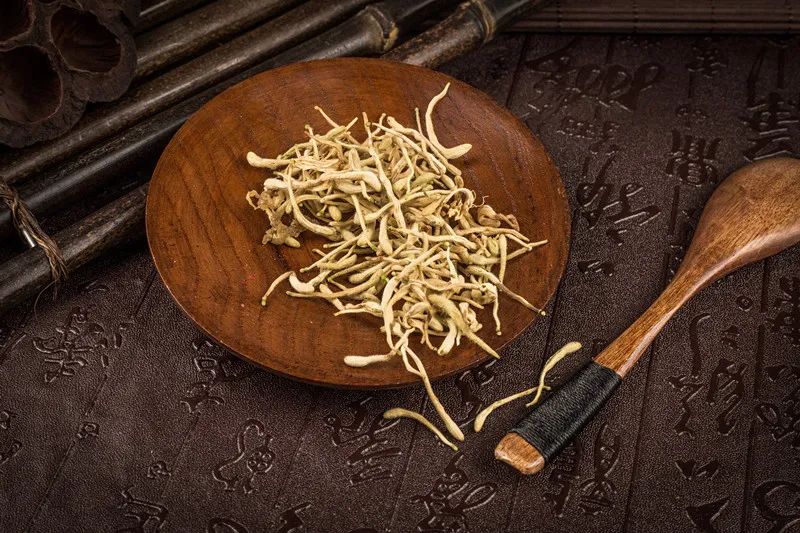
Clinical Applications
1. Abscesses, sore throat, erysipelas
This herb is sweet and cold, effectively clearing heat and detoxifying, making it a key medicine for treating heat-toxicity and pain. It is suitable for various external abscesses and internal sores, sore throat, and erysipelas. For initial stages of sores and abscesses with redness, swelling, and pain, it can be used alone in decoction and the residue applied externally; it can also be combined with Dāng Guī (当归), Chì Sháo (赤芍), Bái Zhǐ (白芷), as in Xiān Fāng Huó Mìng Yǐn (仙方活命饮); for treating deep-rooted abscesses, it is often used with Yě Jú Huā (野菊花), Pú Gōng Yīng (蒲公英), as in Wǔ Wèi Xiāo Dú Yǐn (五味消毒饮); for abdominal pain, it can be combined with Dāng Guī, Dì Yú (地榆), Xuán Shēn (玄参), as in Qīng Cháng Yǐn (清肠饮); for lung abscess with cough and expectoration of pus and blood, it can be combined with Yú Xīng Cǎo (鱼腥草), Lú Gēn (芦根), Yì Yǐ Rén (薏苡仁) for clearing lung and expelling pus; for sore throat, it can be used with Bǎn Lán Gēn (板蓝根), Shān Dòu Gēn (山豆根), Mǎ Bó (马勃) for detoxifying and relieving throat pain;
for blood heat and severe erysipelas, it can be combined with Dà Qīng Yè (大青叶), Bǎn Lán Gēn, Zǐ Huā Dì Dīng (紫花地丁).
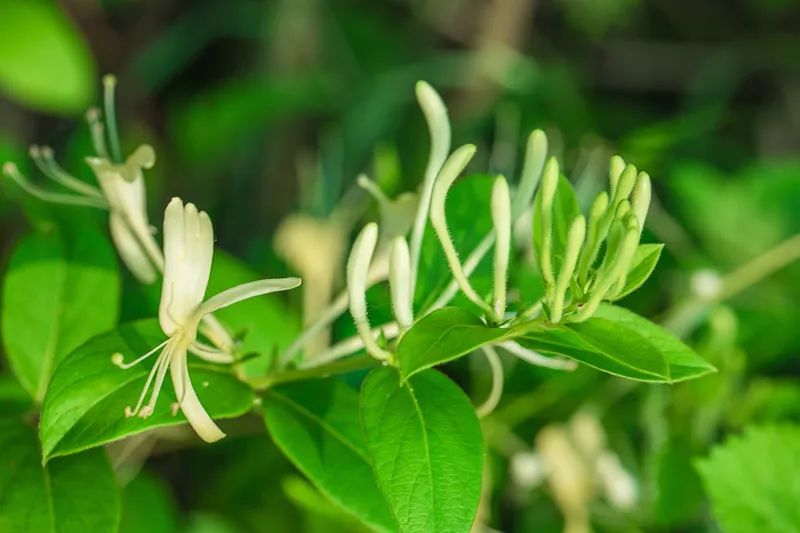
2. Wind-heat colds, febrile diseases
This herb is sweet, cold, and light, aromatic and dispersing, capable of both clearing heat and detoxifying, as well as dispersing wind-heat, suitable for external wind-heat and febrile diseases. For the initial stages of febrile diseases with fever, headache, sore throat, and thirst, it is often used with Lián Qiáo (连翘), Bò Hé (薄荷), Niú Bàng Zǐ (牛蒡子), as in Yín Qiáo Sǎn (银翘散); for febrile diseases with strong heat and thirst, it can be combined with Shí Gāo (石膏), Zhī Mǔ (知母) for clearing heat and draining fire; this herb can also be combined with Shēng Dì Huāng (生地黄), Xuán Shēn for cooling blood and clearing heat, treating heat entering the nutrient level with high fever at night, restlessness, and insomnia, as in Qīng Yíng Tāng (清营汤); for heat entering the blood level with high fever, delirium, rashes, and bleeding, it is often combined with Lián Qiáo, Shēng Dì Huāng, as in Shén Xī Dān (神犀丹);
it can also clear summer heat, brewed as a tea, or used as Honeysuckle Decoction, or combined with fresh Biǎn Dòu Huā (扁豆花), fresh Hé Yè (荷叶) for treating summer heat.
3. Heat-toxicity dysentery
This herb is cold in nature, with effects of clearing heat and detoxifying, cooling blood, and stopping dysentery, thus it can be used to treat heat-toxicity dysentery with pus and blood in the stool, either used alone in strong decoction or combined with Huáng Lián (黄连), Huáng Qín (黄芩), Bái Tóu Wēng (白头翁) to enhance the effect of stopping dysentery.
Dosage and Administration
Decoction, 6-15g. For dispersing wind-heat and clearing internal heat, fresh herbs are preferred; stir-fried is suitable for heat-toxicity dysentery; decoction is often used for summer heat and thirst.
Precautions
Should not be used by those with spleen and stomach deficiency-cold or qi deficiency with pus-filled sores.
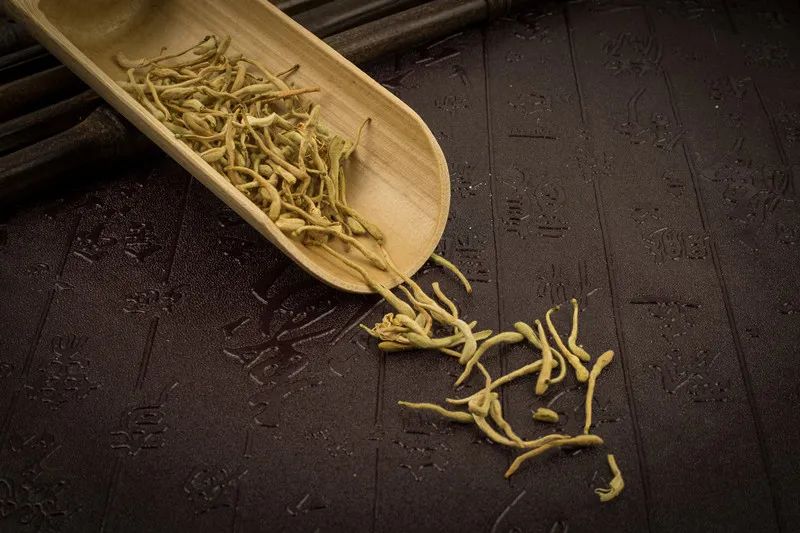
In nature, some flowers are known for their beauty, like the peony; some are famous for their pride, like the plum blossom; while Honeysuckle is renowned for its medicinal properties— the most primitive and natural plant antibiotic. Its broad-spectrum antibacterial effects strongly inhibit various pathogenic bacteria.
Modern research indicates that Honeysuckle mainly contains organic acids such as chlorogenic acid, isochlorogenic acid, and caffeic acid, flavonoids like luteolin and hyperoside, triterpenoid saponins, and volatile oils. The chlorogenic acid compounds and other components have certain inhibitory effects on various pathogenic bacteria such as Staphylococcus aureus, hemolytic streptococcus, Shigella, and Vibrio cholerae. It also has some antiviral effects against influenza and coxsackie viruses.
Health Benefits of Honeysuckle
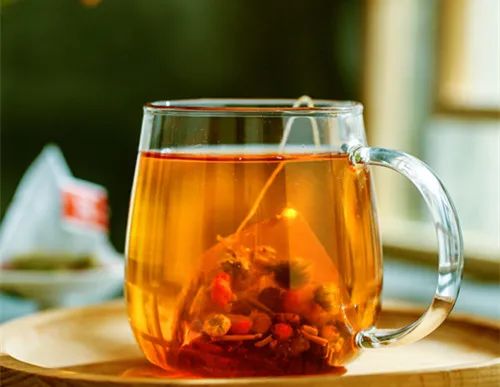
1. Honeysuckle Tea
A common way to use Honeysuckle is to brew it as tea. Place about 2-3 grams of dried Honeysuckle in a teacup, pour in water at about 90°C, cover, and steep for a while. After three minutes, open the lid, and the brewed Honeysuckle tea will have a fragrant taste.
2. Honeysuckle + Lian Qiao: Detoxifying and Relieving Itch
For summer dermatitis and eczema causing skin itching, you can drink Honeysuckle and Lian Qiao tea. Honeysuckle clears heat and detoxifies, while Lian Qiao dispels dampness and relieves itching, and their combination is effective.(Note: Lian Qiao is bitter and cold, should not be taken in excess or for long periods)
3. Honeysuckle + Goji Berries: Eye Protection and Brightening
Honeysuckle clears internal heat and removes red blood vessels from the eyes; Goji berries nourish the liver and kidneys, clear the liver, and brighten the eyes. Together, they can help keep our eyes clear and bright.
4. Honeysuckle + Mint: Soothe Liver and Relieve Stress, Alleviate Dizziness
In hot summer weather, people often experience headaches and dizziness. Honeysuckle clears heat and relieves summer heat, while mint cools the heart and lungs, and its aroma can open the orifices and promote circulation. Drinking Honeysuckle and mint tea can not only alleviate headaches and dizziness but also soothe the liver and relieve summer irritability.
Precautions: Honeysuckle is slightly cold in nature, and those with spleen and stomach deficiency-cold, weak individuals, and women during menstruation should avoid it. Healthy individuals should also not consume it for extended periods.

Harvesting and Purchasing Tips
Honeysuckle is generally harvested for the first time in mid to late May and for the second time in mid to late June. It is best to harvest when the flower buds are swollen, turning from green to white, and have not yet opened. After harvesting, they should be dried immediately to prevent spoilage.
High-quality Honeysuckle is rod-shaped, thicker at the top and thinner at the bottom, light green to white, free of impurities, with a faint floral fragrance, and feels relatively firm to the touch.

